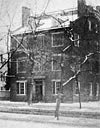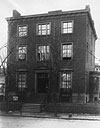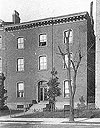At all times of the year, Mr. Lincoln’s White House was besieged by those seeking favors and jobs. In the summer, the White House was also besieged by mosquitoes, heat, and the fetid stench of the Potomac Canal. As a consequence, the President usually commuted from his residence at the cooler Soldiers Home to the hothouse nearer the Potomac. Historian Matthew Pinsker wrote: “The cottages at the Soldiers’ Home offered an attractive alternative to the White House, especially in hot weather, because they were well situated on cool, shaded hills. They also offered the advantage of being outside the city while not too far from the presidential office. It took an ordinary carriage driver about half an hour to navigate the three-mile journey across the District. In the Civil War era, the grounds covered nearly three hundred acres, offering a panoramic view of the capital and surrounding countryside. At the outset of the Lincoln administration, a local newspaper praised the area as ‘one of the most charming rural retreats in the vicinity of Washington.”1
Journalist Noah Brooks recalled: “In the summer the family lived in a stone cottage on the reservation belonging to the Government, in the suburbs of Washington, known as the Soldiers’ Home. A few servants were then kept at the White House, and in case of extraordinary business being on hand the President tarried there all night. But usually he was driven out at the close of the day’s work, and the evenings at the Soldiers’ Home cottage were often very delightful. The distance from the city kept away importunate office-seekers and other petitioners, and familiar friends would call and help to pass the evening in social chat. One or two would sometimes be invited to spend the night, and the family circle was then more like that of a private household than at other time during the Presidential term.”2
Mr. Lincoln also escaped to the homes of some cabinet members, primarily that of Secretary of State William Seward. Seward’s wife was seldom in residence – so there was no need to explain the absence of Mrs. Lincoln on such visits. Mrs. Lincoln didn’t like Seward – or the wife of Secretary of War Edwin M. Stanton or the daughter of Secretary of the Treasury Salmon P. Chase. Indeed, her only real friend in the official inner circle was Mary Jane Welles, but President Lincoln was not socially close to Secretary of the Navy Gideon Welles, who had a reputation for stuffiness.
Mrs. Lincoln was particularly jealous of the beautiful Kate Chase, who was the driving force behind her father’s presidential ambitions. When Kate married the dull, rich, and unscrupulous William Sprague, Mr. Lincoln had to attend the wedding alone. The consequence was that the Lincoln’s social life with cabinet members was very limited. The Stanton’s occupied a “cottage” next to the Lincolns at the Soldiers Home so that their children could and did play together. The President and the austere Secretary of War may have enjoyed participating in their games as much as their offspring did.
Like Stanton, Seward liked the Lincoln boys, to whom he gave a pair of kittens. But Mr. Lincoln went to Seward’s house alone, or with a secretary. “The protocol was unusual, but Lincoln liked to drop in on people, and the horde of office seekers that inundated the White House made it imperative for him to have some sanctuary,” wrote Seward biographer John M. Taylor. “In the Seward parlor, away from Mary Lincoln and the office seekers, Lincoln and Seward could stretch out in front of a fire and discuss anything that came to mind. Both men were lawyers, and for Lincoln these visits may have been reminiscent of relaxed hours on the circuit in Illinois. Both men were keen judges of character and doubtless spent many hours discussing prospective appointments. The two men even had their little bets. Once, when navy ships were attempting to corner a Confederate blockade runner, the Nashville, a friend of Lincoln’s telegraphed from new York City: ‘You have won the quart of hazelnuts from the Secretary of State. The Nashville is not destroyed, but is actively at work.”3
Unlike the stuffy Chase, Stanton and Welles, Seward enjoyed telling a good, sometimes off-color, story. Seward – whom often seemed to be surrounded by political enemies on all sides – occupied a protected place in the Cabinet and the President occupied a protected place at his fireside. When the President visited the injured Seward shortly before his own assassination, his familiarity took an extraordinary turn. In order to converse with the bedridden secretary of state, Mr Lincoln threw “himself, in almost boyish exultation, at full length across the bed, supporting his head upon one hand, and in this manner reciting the story of the collapse of the Rebellion.” Before he left, Mr. Lincoln exclaimed: “And now for a day of Thanksgiving!”4
Footnotes
- Matthew Pinsker, Lincoln’s Sanctuary: Abraham Lincoln and the Soldier’s Home, p. 2.
- Noah Brooks, Abraham Lincoln: the Nation’s Leader in the Great Struggle Through Which was Maintained the Existence of the United States, pp. 420-421.
- John M. Taylor, William Seward: Lincoln’s Right Hand Man, pp. 187-188.
- Francis Carpenter, Six Months at the White House, p. 290.
Visit











